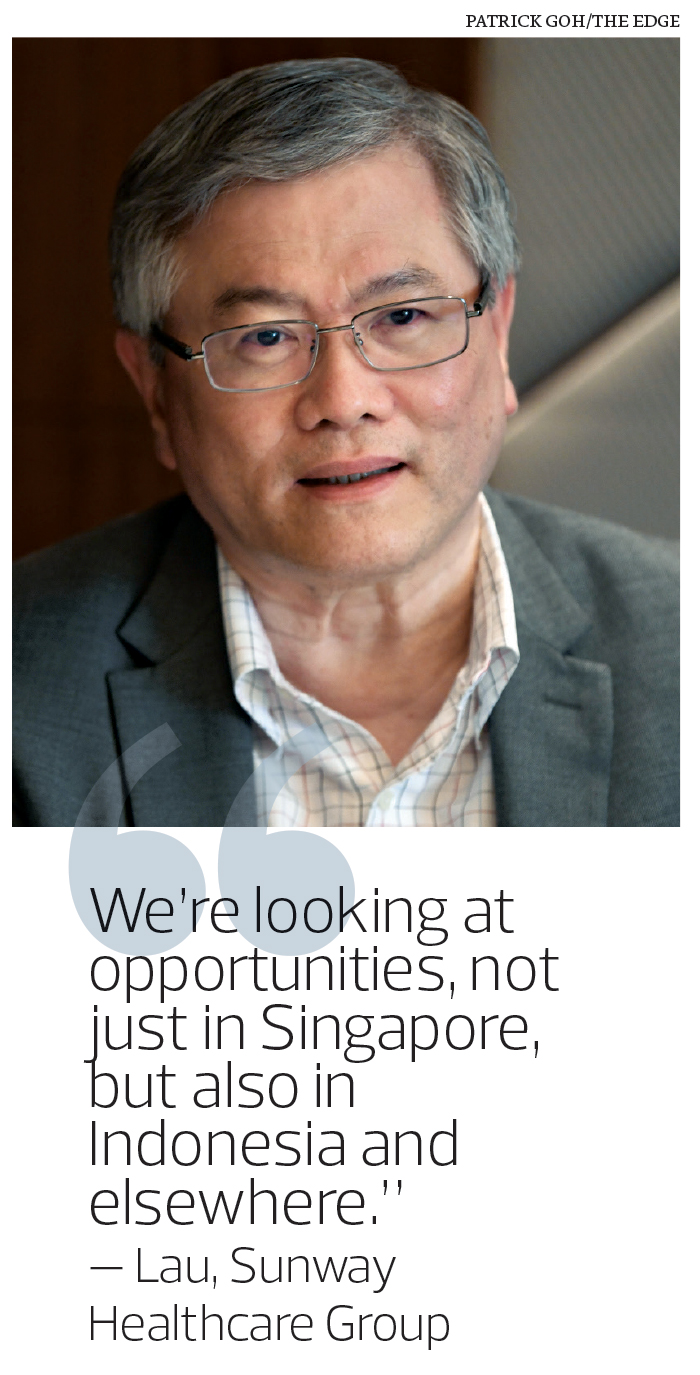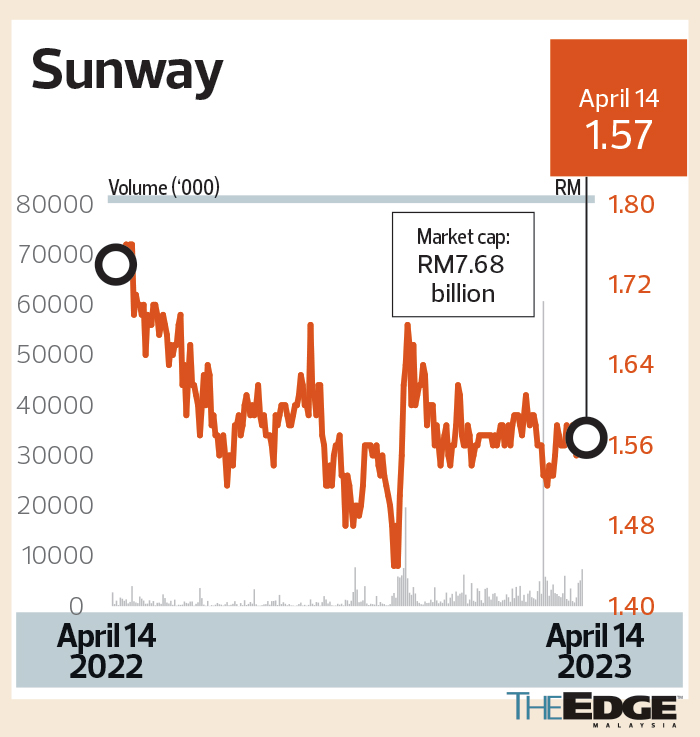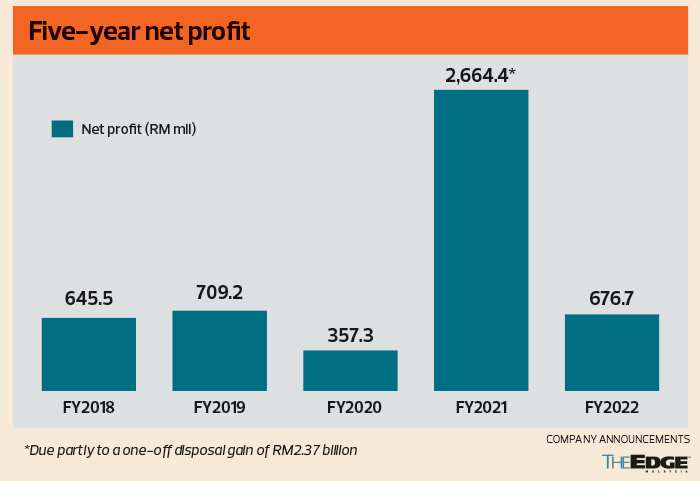
The 800-acre Sunway City Kuala Lumpur, located 20 minutes from the KL city centre, is a fully integrated green township comprising residential, commercial, hospitality, retail, leisure, healthcare and education components
This article first appeared in The Edge Malaysia Weekly on April 17, 2023 - April 23, 2023
HAVING gone through the boom and busts of the past few decades, including the Asian financial crisis — arguably the most testing — conglomerate Sunway Bhd reckons its present constitution is sufficiently healthy to ensure it remains resilient, even though a global economic slowdown appears inevitable this year.
For starters, its healthcare segment has emerged as a key pillar, underpinned by the continued expansion of its medical centres. As a result, the planned healthcare listing of the business on Bursa Malaysia is likely to be ahead of its original targeted timeline.
In an interview with The Edge, Sunway Healthcare Group (SHG) president Datuk Lau Beng Long does not rule out the healthcare listing taking place earlier than 2027, which bodes well for the conglomerate that has well-established property development and construction businesses.
Sunway now has three tertiary hospitals in its stable: Sunway Medical Centre Sunway City (SMC SC), Sunway Medical Centre Velocity (SMC Velocity) and Sunway Medical Centre Penang (SMC Penang).
“Based on the shareholders’ agreement with GIC Pte Ltd, the listing has to occur by October 2027. For healthcare, the valuation is based on Ebitda [earnings before interest, taxes, depreciation and amortisation] rather than PE (price-to-earnings). Even though the collaboration has been [in existence] for only 1½ years, we have exceeded what is in [the shareholders’ agreement]. So, chances are pretty good [for a listing before 2027],” Lau says.
In June 2021, Sunway announced that Singapore sovereign wealth fund GIC was acquiring a 16% stake in Sunway Healthcare Holdings Sdn Bhd (SHH) for RM750 million, based on a valuation of RM4.69 billion. Sunway owns the remaining 84% of SHH.
GIC is familiar with Sunway, as it had partnered the group more than 20 years ago after the 1997/98 Asian financial crisis hit. In 1999, GIC struck a deal with the Sunway group to buy a 48% stake in Sunway Pyramid. It also acquired a nearly 12% equity interest in Sunway City Bhd to become a substantial shareholder. GIC cashed out 10 years later, before the delisting of Sunway City in August 2011, following its merger with Sunway Holdings Bhd.
Contribution from Sunway’s healthcare business has been on the rise, raking in a profit before tax of RM176.7 million, or one-fifth of the group’s PBT in the financial year ended Dec 31, 2022 (FY2022), against RM17.39 million in FY2020.
Property investment was the largest contributor for the group, with RM236.9 million in PBT, or 25.8% of total PBT, followed by construction at RM186.6 million (20.3%).
A new hospital generally takes one to two years to turn a profit, says Lau, but Sunway’s hospitals appear to have outperformed the average.
“After we opened SMC Penang in November last year, we had already achieved Ebitda positive in January this year. By next year, we should be PBT positive.
“It’s the same for SMC Velocity. Even though we opened in September 2019, and then the MCO (Movement Control Order) was implemented in March 2020, we’re already Ebitda positive end-2020, and PBT positive end-2021, and then profitable last year,” he says.
Lau is unfazed by a potential economic downturn, as he does not believe the healthcare business is likely to experience a slowdown, given that Sunway’s hospitals are busier than before the pandemic.
“I don’t think the economy will affect the demand for healthcare. In private healthcare, a lot of people use medical insurance. In our case, 65% of our patients use medical insurance. In fact, I understand from insurance companies and third-party administrators that there has been an uptick in medical insurance,” he says.
Moreover, he observes that the number of people going for annual medical check-ups is higher than pre-pandemic, as it was difficult to do so after Covid-19 struck three years ago. He notes that some who were infected by Covid-19 still need to seek follow-up treatments, owing to the occurrence of symptoms.
Another supporting factor for private healthcare is that government hospitals are unable to catch up with the medical needs of the growing population and urban migration.
“The government facilities really cannot cope with that. So, those who can afford it will come to private hospitals. That’s why we foresee an opportunity,” says Lau.
On the positioning of Sunway’s healthcare arm, he says:“We will not differentiate ourselves in terms of having a bigger network, but having the biggest tertiary and quaternary private hospitals. That means we can take care of high-end, complex, interdisciplinary type of cases. That’s how we differentiate ourselves.”
Given Sunway’s ability to handle more complex cases, Lau points out that the group’s revenue per bed is higher than its peers.
In anticipation of continued growth, the group has been embarking on expansion plans, which will increase the total number of beds to 2,600 in the next two years from about 900 at present.
In comparison, IHH Healthcare Bhd was operating 11,881 beds as at end-December 2022, at its hospitals in Malaysia, Singapore, Europe and Greater China. KPJ Healthcare Bhd — which has 29 hospitals in Malaysia, Indonesia, Bangladesh and Thailand — operates more than 3,000 beds.
Phase two of Sunway’s SMC Velocity is expected to be completed by the third quarter (3Q) of this year, while SMC Ipoh and SMC Kota Damansara, Selangor, are scheduled to open in 2Q or 3Q next year.
SMC Penang, which was just opened last November, is about to see the opening of its second phase, according to Lau.
In total, some RM1.2 billion has been spent on the expansion plans. The funds were raised through GIC’s RM750 million investment, as well as debt financing and internally generated funds. Last month, SHG set up a sustainability financing framework for the issuance of RM5 billion worth of sukuk for future use.
Three other new hospitals, which are in the planning stage, will be located in Iskandar Puteri, Johor, Paya Terubong, Penang, and Kota Baru, Kelantan.
Last year, the average occupancy rate of Sunway’s SMC SC and SMC Velocity stood at above 60%, while SMC Penang was about 30%, owing to the short operating duration. Its competitors IHH and KPJ had occupancy rates of 70% and 64% respectively.
The group plans to set its sights on overseas markets, says Lau. “We had our first foray of this facility in Singapore, which is an ambulatory care centre with no overnight … We’re looking at opportunities, not just in Singapore, but also in Indonesia and elsewhere.”
Medical tourism boost
Following the reopening of borders, the group aims to increase the contribution from medical tourism. Over the medium term of about three years, it aims to raise revenue contribution from medical tourism two- to threefold from 10% at present.
Lau observes that there has been a return of foreign patients, who used to account for 10% of its patient base before the pandemic, of which 65% to 70% were from Indonesia.
Apart from medical tourism, other strategies to improve revenue for the healthcare segment include extending the average length of stay, in tandem with the increase in the number of complex cases.
At the same time, the group is looking at launching innovative healthcare services to address the needs of underserved patients and expand its market reach, as well as attracting interstate patients.
Its innovative offerings include the introduction of cutting-edge medical technology and services for precise and effective radiotherapy treatments and specialised services such as paediatric oncology, among others.
While building its own hospitals, the group may consider any potential mergers and acquisitions if they fit into its strategy and operating model. Given that Sunway University has a nursing school, the group is unaffected by the global shortage of nurses, as it has its own pipeline of nurses, apart from recruiting from the market.
On the separate matter of the group’s fintech business, following the purchase of a 51% stake in credit reporting agency Credit Bureau Malaysia (CBM) two years ago, Sunway president Tan Sri Chew Chee Kin says the group will continue to grow CBM as part of Sunway’s fintech verticals, which include Sunway Money and Sunway SCF.
Sunway Money, Malaysia’s first completely online licensed remittance house, provides the convenience of overseas money transfer at competitive rates. It recently entered into a collaboration with Wavpay Systems Sdn Bhd to be the exclusive remittance service provider on the Wavpay e-wallet app, further advancing the fintech industry in Malaysia in the areas of invoice factoring and supply chain financing.
Sunway SCF provides online services to assist companies in managing their working capital through an early invoice payment programme. It also provides working capital solutions to Sunway’s extensive ecosystem of business partners.
“CBM, Sunway Money and Sunway SCF are synergistic to Sunway’s fintech verticals and form a unique value proposition by capitalising on Sunway’s extensive ecosystem,” Chew says.
It was reported that the CBM acquisition was part of Sunway’s efforts to secure a digital banking licence and offer financial services to small and medium enterprises (SMEs). The digital banking bid failed to be among the five winners, which were announced by Bank Negara Malaysia a year ago.
CBM is widely used by financial institutions, telecommunications companies, large corporations, SMEs and consumers for self-checks. It is also able to capitalise on Sunway’s extensive ecosystem in providing credit checks for suppliers, vendors, contractors and tenants, among others.
Save by subscribing to us for your print and/or digital copy.
P/S: The Edge is also available on Apple's App Store and Android's Google Play.
- Malaysian officials advise Anwar to soften Israel-Hamas rhetoric for Trump — Bloomberg
- Analysts slash Hartalega's earnings outlook on lower sales volume, margins
- Trump says he will introduce 25% tariffs on autos, pharmaceuticals and chips
- Amir Hamzah: Targeted EPF withdrawals no longer relevant after introduction of Flexible Account
- Singapore banks hand billions of surplus capital to investors
- Vietnam approves over US$8b rail link project to connect with China
- Salcon bags RM70.5 mil pipe replacement contract
- Italy’s Panetta says excessive regulation is risk for EU banks
- MPI posts 24.5% rise in 4Q net profit due to lower operating costs
- Mara aims to reduce non-performing loans below 30% — Asyraf Wajdi




